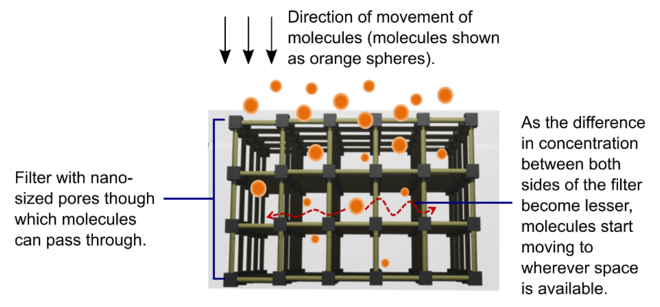Filtration can be found in many aspects of everyday life, such as a strainer filtering away tea leaves while brewing a cup of tea. Since the tea leaves are bigger than the pores of the strainer, they cannot pass through and are thus separated from the hot brew. What if there was a need to filter tiny particles 107-8 times smaller than a tea leaf?
 Molecular diffusion direction becomes orthogonal at low concentration gradient, illustrated using a metal-organic framework thin film. Image Credit: Ritesh Haldar
Molecular diffusion direction becomes orthogonal at low concentration gradient, illustrated using a metal-organic framework thin film. Image Credit: Ritesh Haldar
Making a strainer capable of filtering these nanoparticles was extremely difficult until recently.
However, breakthroughs in chemical science and related technology have enabled scientists all around the world to construct strainers capable of separating molecules as tiny as hydrogen (~ 2*10–10 m).
Tanmoy Maity, Pratibha Malik, Ritesh Haldar, and colleagues from the Tata Institute of Fundamental Research, Hyderabad (TIFRH), provide a more precise understanding of the movement of molecules through a strainer where the size of the pores can be minimized to Ångstrom (10–10 m) scale in a recent study published in Nature Communications.
The results of this study give new possibilities for creating filtering procedures that are widely utilized in industries that are more effective.
Small molecules must be separated and purified using molecular strainers before being employed in the production of numerous goods in the plastic, petroleum, and pharmaceutical sectors.
Sieving is not as simple as sifting tea leaves at the molecular level. As molecules interact with the sieve’s material, the situation becomes a little more convoluted and its nature is more unpredictable.
Furthermore, it is extremely difficult to anticipate and observe the direction of molecular motion across the few Ångstrom (10–10 m) small sieves. The ability to construct molecular filters that can create pure chemicals at a far cheaper cost than present techniques would be made possible by a better knowledge of such molecular motion.
Haldar and colleagues examine a unique molecular strainer called a metal-organic framework (MOF), wherein sieve size could be adjusted from 1-100 Ångstroms (10–10 m) to remove a single molecule from a mixture according to its size.
They created a thin layer of this material, about 300 nm thick, such that it could serve as a filter. It was understood that when a gradient existed across the filter, molecules would travel from an area of greater molecule concentration to one of lower concentration.
As the concentration gradient narrows, molecules travel in a direction where space is available, even though that path is orthogonal to the gradient, according to experimental findings from this TIFRH research.
The study’s findings offer a fresh framework for creating filters with such small pore sizes and open up new directions for research into how they could be used to separate gases and ions.
Journal Reference:
Maity, T., et al. (2023) Chemically routed interpore molecular diffusion in metal-organic framework thin films. Nature Communications. doi:10.1038/s41467-023-37739-8.